Numeracy and Data Analysis: Presenting Data, Central Tendency Measures, and Linear Forecasting Models
VerifiedAdded on 2023/06/14
|9
|1406
|143
AI Summary
This report covers presenting data in tabular and graphical formats, calculating measures of central tendency, and using linear forecasting models to compute values of m and c for humidity levels in Norwich. It includes steps for finding mean, median, mode, range, and standard deviation, as well as equations for computing m and c values and estimating humidity levels for day 11 and day 13. This report is useful for students studying numeracy and data analysis.
Contribute Materials
Your contribution can guide someone’s learning journey. Share your
documents today.
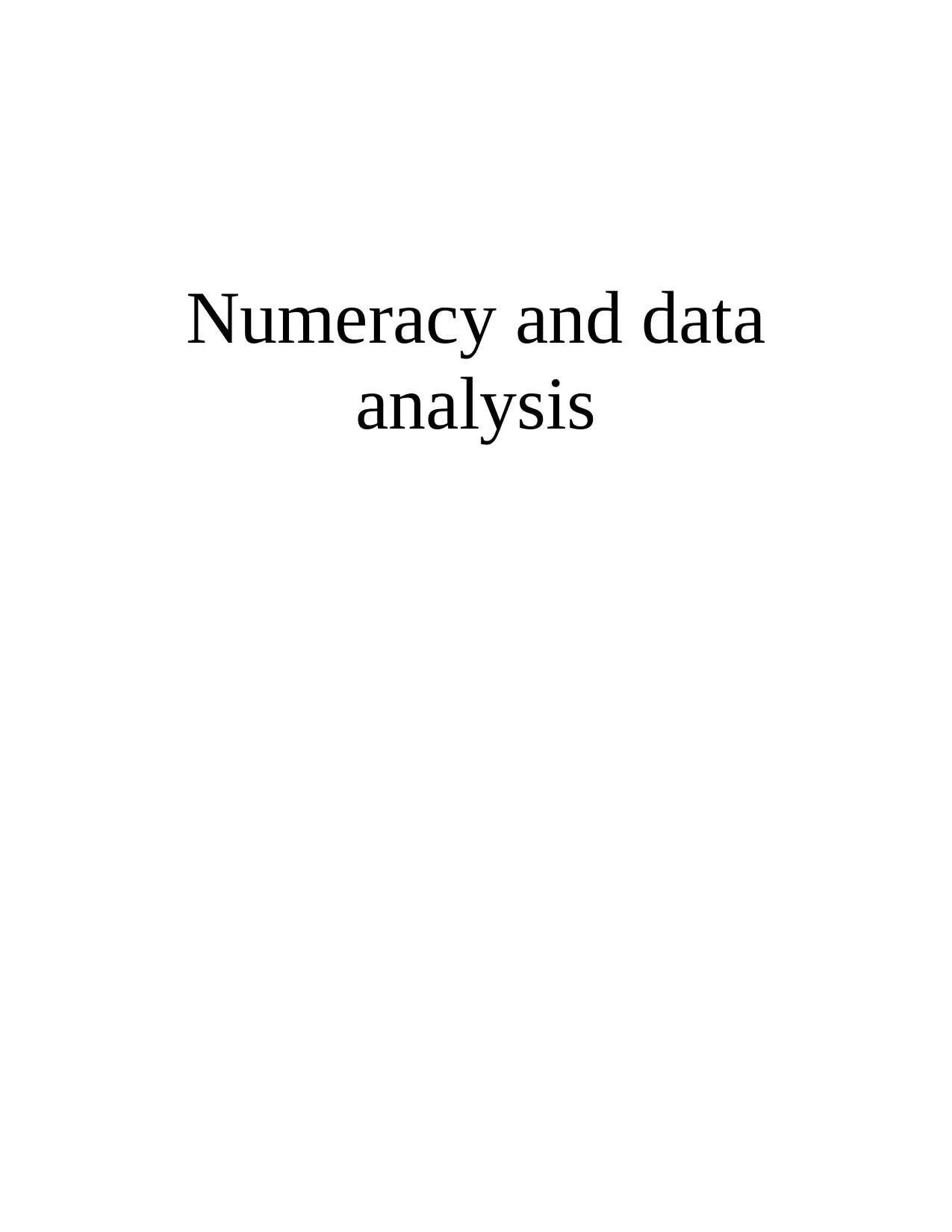
Numeracy and data
analysis
analysis
Secure Best Marks with AI Grader
Need help grading? Try our AI Grader for instant feedback on your assignments.

Table of Contents
INTRODUCTION...........................................................................................................................1
MAIN BODY...................................................................................................................................1
1. Presenting the data regarding ten days humidity of Norwich in tabular format................1
2. Representing the level of humidity in graphical format using bar and pie chart...............1
3. Calculation of measures of central tendency and steps for the same.................................3
4. Computation of 'm' and 'c' values using linear forecasting models....................................5
a.) Calculation of 'm' value using linear model.....................................................................5
b.) calculation of 'c' values for humidity level of Norwich ...................................................5
c.)computation of day 11 and day 13 humidity level of Norwich by using equation ...........6
CONCLUSION................................................................................................................................6
REFERENCES ...............................................................................................................................7
INTRODUCTION...........................................................................................................................1
MAIN BODY...................................................................................................................................1
1. Presenting the data regarding ten days humidity of Norwich in tabular format................1
2. Representing the level of humidity in graphical format using bar and pie chart...............1
3. Calculation of measures of central tendency and steps for the same.................................3
4. Computation of 'm' and 'c' values using linear forecasting models....................................5
a.) Calculation of 'm' value using linear model.....................................................................5
b.) calculation of 'c' values for humidity level of Norwich ...................................................5
c.)computation of day 11 and day 13 humidity level of Norwich by using equation ...........6
CONCLUSION................................................................................................................................6
REFERENCES ...............................................................................................................................7
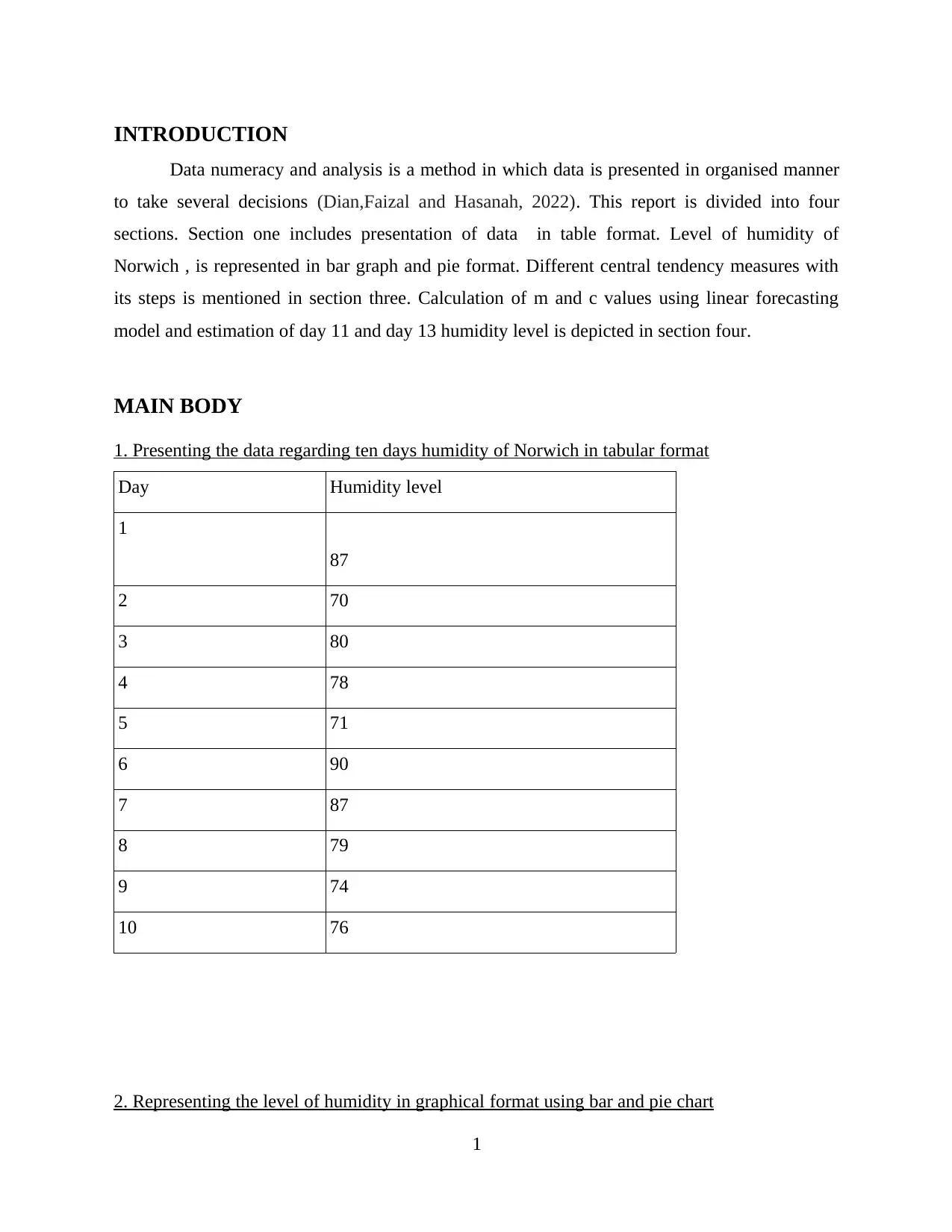
INTRODUCTION
Data numeracy and analysis is a method in which data is presented in organised manner
to take several decisions (Dian,Faizal and Hasanah, 2022). This report is divided into four
sections. Section one includes presentation of data in table format. Level of humidity of
Norwich , is represented in bar graph and pie format. Different central tendency measures with
its steps is mentioned in section three. Calculation of m and c values using linear forecasting
model and estimation of day 11 and day 13 humidity level is depicted in section four.
MAIN BODY
1. Presenting the data regarding ten days humidity of Norwich in tabular format
Day Humidity level
1
87
2 70
3 80
4 78
5 71
6 90
7 87
8 79
9 74
10 76
2. Representing the level of humidity in graphical format using bar and pie chart
1
Data numeracy and analysis is a method in which data is presented in organised manner
to take several decisions (Dian,Faizal and Hasanah, 2022). This report is divided into four
sections. Section one includes presentation of data in table format. Level of humidity of
Norwich , is represented in bar graph and pie format. Different central tendency measures with
its steps is mentioned in section three. Calculation of m and c values using linear forecasting
model and estimation of day 11 and day 13 humidity level is depicted in section four.
MAIN BODY
1. Presenting the data regarding ten days humidity of Norwich in tabular format
Day Humidity level
1
87
2 70
3 80
4 78
5 71
6 90
7 87
8 79
9 74
10 76
2. Representing the level of humidity in graphical format using bar and pie chart
1

2
1
2
3
4
5
6
7
8
9
10
1
2
3
4
5
6
7
8
9
10
Secure Best Marks with AI Grader
Need help grading? Try our AI Grader for instant feedback on your assignments.

3. Calculation of measures of central tendency and steps for the same
Mean – It is a measure of central tendency which helps represent the complete series
using a single value (Donleavy and et.al., 2018). Mean is defined as a average of
numbers. It is computed using adding all the given numbers and divide the sum by
number of observations present in data set. There are three types of mean: harmonic
mean, geometric mean and arithmetic mean.
Steps for finding mean of ten days humidity level -
Step-1: Sum all the given numbers.
Step-2: Divide the addition of numbers by number of observations.
Series - 87, 70, 80, 78, 71 , 90, 87 , 79 , 74, 76
Mean = Addition of observation / Number of observation
= 792 / 10
= 79.2
Median - It is mid value of the given data which is find out by sorting data in ascending
to descending order (Larsen and et.al., 2022). In case of even observation it is find out by
taking the average of middle numbers whereas in case of odd observations mid vale will
be the median of the given numbers.
Step – 1: Sort all the data in highest to lowest manner.
Step -2 : In case of odd observation, middle value in the series will be median.
3
1 2 3 4 5 6 7 8 9 10
0
10
20
30
40
50
60
70
80
90
100
DAY
Humidity level
Mean – It is a measure of central tendency which helps represent the complete series
using a single value (Donleavy and et.al., 2018). Mean is defined as a average of
numbers. It is computed using adding all the given numbers and divide the sum by
number of observations present in data set. There are three types of mean: harmonic
mean, geometric mean and arithmetic mean.
Steps for finding mean of ten days humidity level -
Step-1: Sum all the given numbers.
Step-2: Divide the addition of numbers by number of observations.
Series - 87, 70, 80, 78, 71 , 90, 87 , 79 , 74, 76
Mean = Addition of observation / Number of observation
= 792 / 10
= 79.2
Median - It is mid value of the given data which is find out by sorting data in ascending
to descending order (Larsen and et.al., 2022). In case of even observation it is find out by
taking the average of middle numbers whereas in case of odd observations mid vale will
be the median of the given numbers.
Step – 1: Sort all the data in highest to lowest manner.
Step -2 : In case of odd observation, middle value in the series will be median.
3
1 2 3 4 5 6 7 8 9 10
0
10
20
30
40
50
60
70
80
90
100
DAY
Humidity level
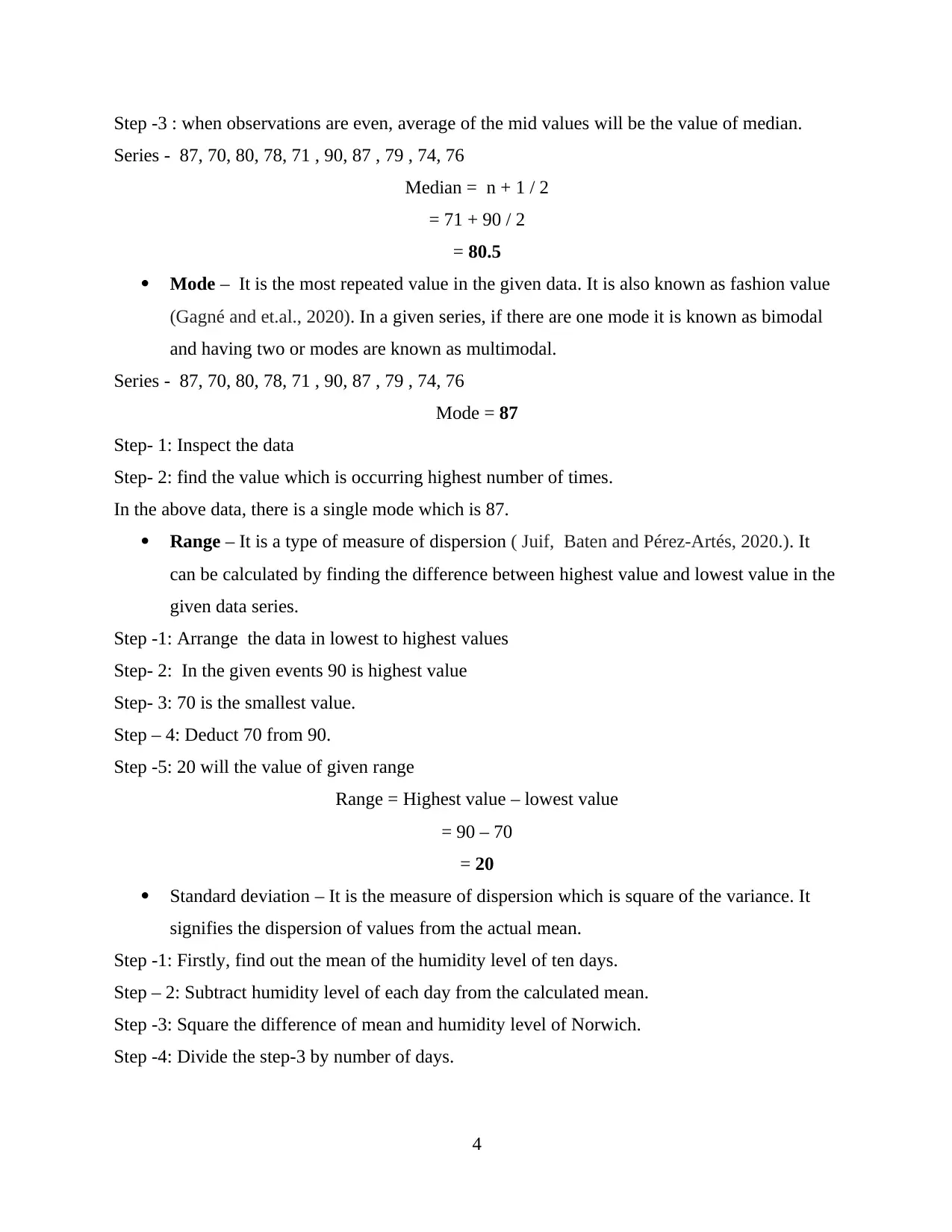
Step -3 : when observations are even, average of the mid values will be the value of median.
Series - 87, 70, 80, 78, 71 , 90, 87 , 79 , 74, 76
Median = n + 1 / 2
= 71 + 90 / 2
= 80.5
Mode – It is the most repeated value in the given data. It is also known as fashion value
(Gagné and et.al., 2020). In a given series, if there are one mode it is known as bimodal
and having two or modes are known as multimodal.
Series - 87, 70, 80, 78, 71 , 90, 87 , 79 , 74, 76
Mode = 87
Step- 1: Inspect the data
Step- 2: find the value which is occurring highest number of times.
In the above data, there is a single mode which is 87.
Range – It is a type of measure of dispersion ( Juif, Baten and Pérez-Artés, 2020.). It
can be calculated by finding the difference between highest value and lowest value in the
given data series.
Step -1: Arrange the data in lowest to highest values
Step- 2: In the given events 90 is highest value
Step- 3: 70 is the smallest value.
Step – 4: Deduct 70 from 90.
Step -5: 20 will the value of given range
Range = Highest value – lowest value
= 90 – 70
= 20
Standard deviation – It is the measure of dispersion which is square of the variance. It
signifies the dispersion of values from the actual mean.
Step -1: Firstly, find out the mean of the humidity level of ten days.
Step – 2: Subtract humidity level of each day from the calculated mean.
Step -3: Square the difference of mean and humidity level of Norwich.
Step -4: Divide the step-3 by number of days.
4
Series - 87, 70, 80, 78, 71 , 90, 87 , 79 , 74, 76
Median = n + 1 / 2
= 71 + 90 / 2
= 80.5
Mode – It is the most repeated value in the given data. It is also known as fashion value
(Gagné and et.al., 2020). In a given series, if there are one mode it is known as bimodal
and having two or modes are known as multimodal.
Series - 87, 70, 80, 78, 71 , 90, 87 , 79 , 74, 76
Mode = 87
Step- 1: Inspect the data
Step- 2: find the value which is occurring highest number of times.
In the above data, there is a single mode which is 87.
Range – It is a type of measure of dispersion ( Juif, Baten and Pérez-Artés, 2020.). It
can be calculated by finding the difference between highest value and lowest value in the
given data series.
Step -1: Arrange the data in lowest to highest values
Step- 2: In the given events 90 is highest value
Step- 3: 70 is the smallest value.
Step – 4: Deduct 70 from 90.
Step -5: 20 will the value of given range
Range = Highest value – lowest value
= 90 – 70
= 20
Standard deviation – It is the measure of dispersion which is square of the variance. It
signifies the dispersion of values from the actual mean.
Step -1: Firstly, find out the mean of the humidity level of ten days.
Step – 2: Subtract humidity level of each day from the calculated mean.
Step -3: Square the difference of mean and humidity level of Norwich.
Step -4: Divide the step-3 by number of days.
4
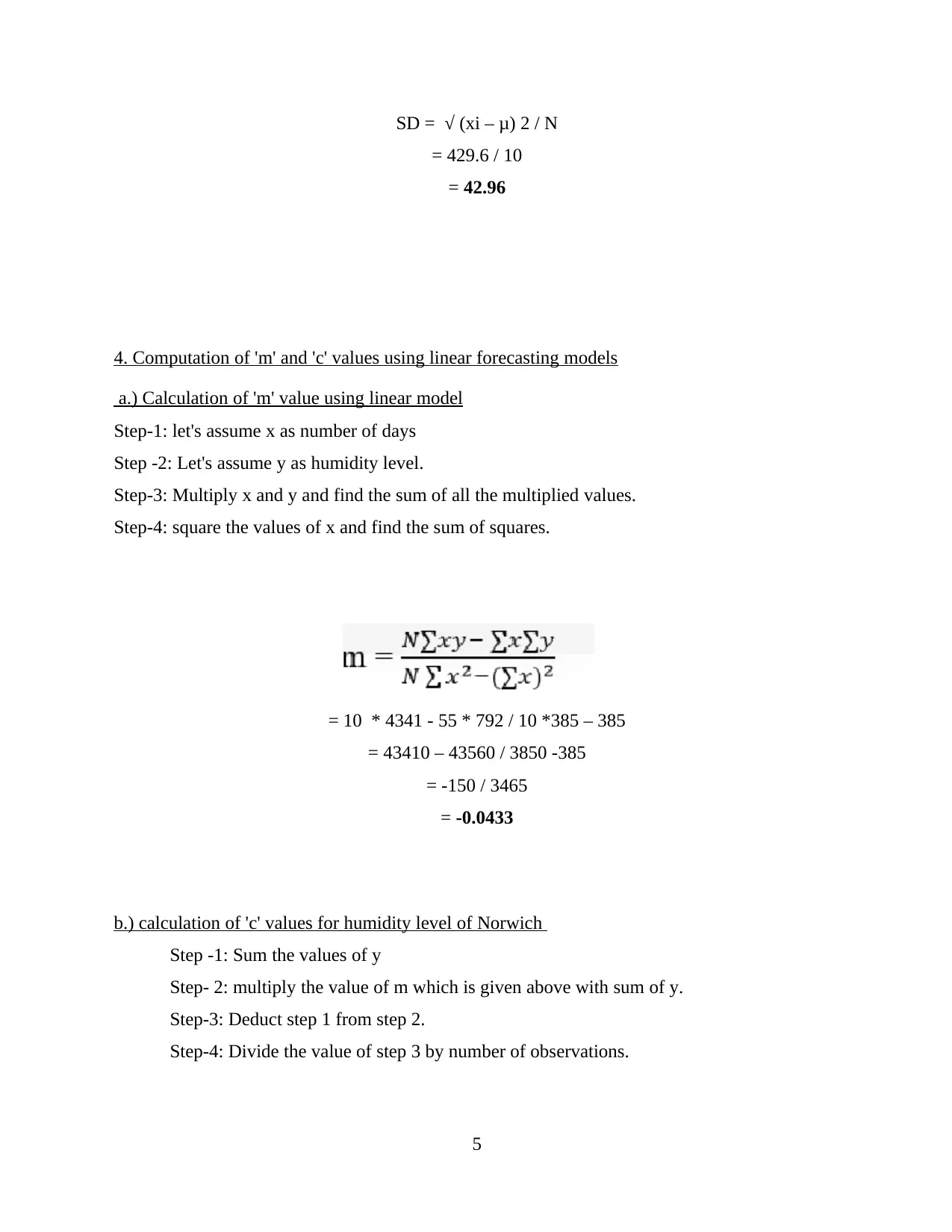
SD = √ (xi – μ) 2 / N
= 429.6 / 10
= 42.96
4. Computation of 'm' and 'c' values using linear forecasting models
a.) Calculation of 'm' value using linear model
Step-1: let's assume x as number of days
Step -2: Let's assume y as humidity level.
Step-3: Multiply x and y and find the sum of all the multiplied values.
Step-4: square the values of x and find the sum of squares.
= 10 * 4341 - 55 * 792 / 10 *385 – 385
= 43410 – 43560 / 3850 -385
= -150 / 3465
= -0.0433
b.) calculation of 'c' values for humidity level of Norwich
Step -1: Sum the values of y
Step- 2: multiply the value of m which is given above with sum of y.
Step-3: Deduct step 1 from step 2.
Step-4: Divide the value of step 3 by number of observations.
5
= 429.6 / 10
= 42.96
4. Computation of 'm' and 'c' values using linear forecasting models
a.) Calculation of 'm' value using linear model
Step-1: let's assume x as number of days
Step -2: Let's assume y as humidity level.
Step-3: Multiply x and y and find the sum of all the multiplied values.
Step-4: square the values of x and find the sum of squares.
= 10 * 4341 - 55 * 792 / 10 *385 – 385
= 43410 – 43560 / 3850 -385
= -150 / 3465
= -0.0433
b.) calculation of 'c' values for humidity level of Norwich
Step -1: Sum the values of y
Step- 2: multiply the value of m which is given above with sum of y.
Step-3: Deduct step 1 from step 2.
Step-4: Divide the value of step 3 by number of observations.
5
Paraphrase This Document
Need a fresh take? Get an instant paraphrase of this document with our AI Paraphraser

= 792 – (-0.0433) * 55 / 10
= 792 + 2.3815 / 10
= 79.44
c.)computation of day 11 and day 13 humidity level of Norwich by using equation
Humidity level.
Day -11
y = mx + c
y= 0.0433 * 11 + 79.44
= 0.4763 + 79.44
= 79.9163
Day-13
y = mx + c
= 0.0433* 13 + 79.44
= 0.5629 + 79.44
= 80
CONCLUSION
From the above report, it can be concluded that measuring several measures of central
tendency and application of linear forecasting models to compute vales of m and c helps to take
various decisions regarding future performance.
6
= 792 + 2.3815 / 10
= 79.44
c.)computation of day 11 and day 13 humidity level of Norwich by using equation
Humidity level.
Day -11
y = mx + c
y= 0.0433 * 11 + 79.44
= 0.4763 + 79.44
= 79.9163
Day-13
y = mx + c
= 0.0433* 13 + 79.44
= 0.5629 + 79.44
= 80
CONCLUSION
From the above report, it can be concluded that measuring several measures of central
tendency and application of linear forecasting models to compute vales of m and c helps to take
various decisions regarding future performance.
6
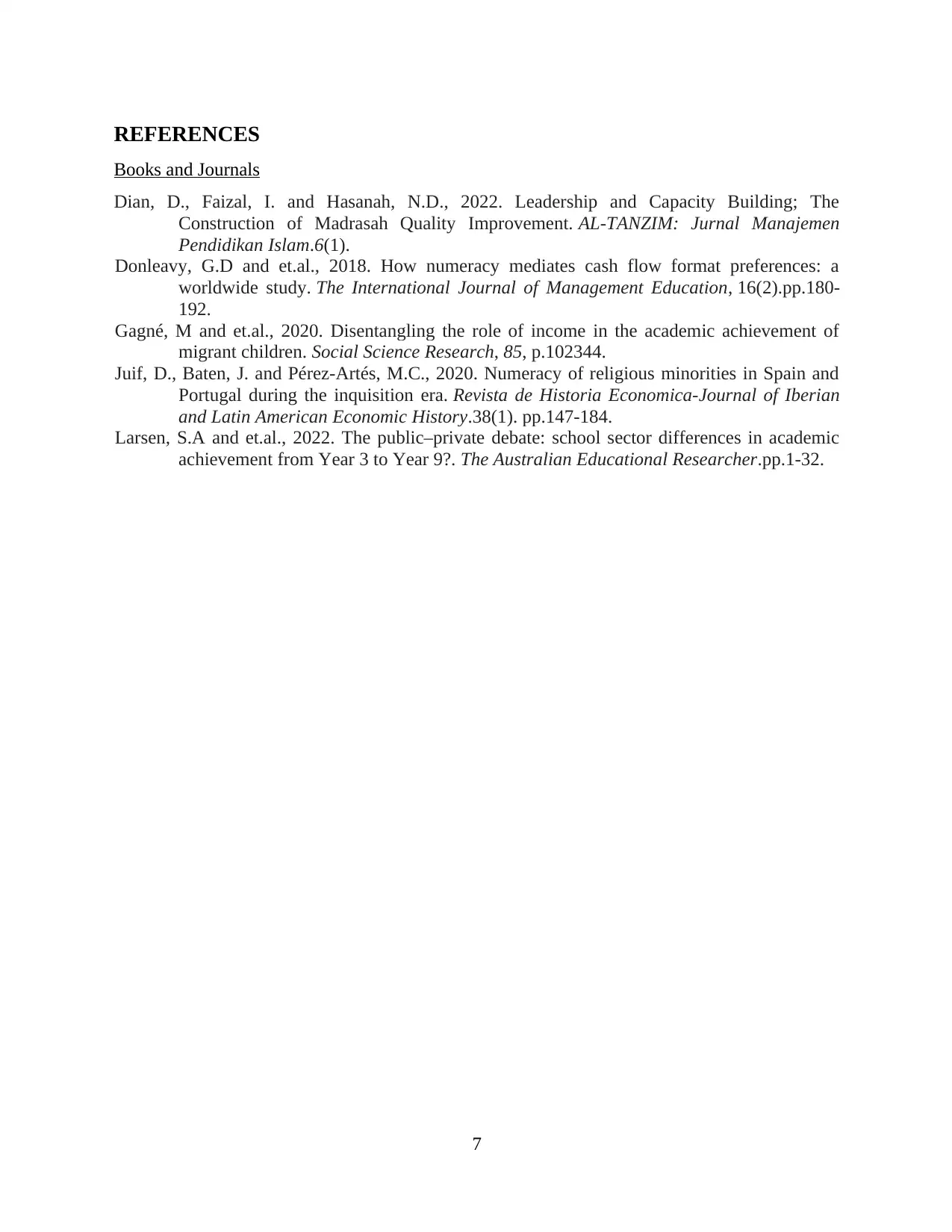
REFERENCES
Books and Journals
Dian, D., Faizal, I. and Hasanah, N.D., 2022. Leadership and Capacity Building; The
Construction of Madrasah Quality Improvement. AL-TANZIM: Jurnal Manajemen
Pendidikan Islam.6(1).
Donleavy, G.D and et.al., 2018. How numeracy mediates cash flow format preferences: a
worldwide study. The International Journal of Management Education, 16(2).pp.180-
192.
Gagné, M and et.al., 2020. Disentangling the role of income in the academic achievement of
migrant children. Social Science Research, 85, p.102344.
Juif, D., Baten, J. and Pérez-Artés, M.C., 2020. Numeracy of religious minorities in Spain and
Portugal during the inquisition era. Revista de Historia Economica-Journal of Iberian
and Latin American Economic History.38(1). pp.147-184.
Larsen, S.A and et.al., 2022. The public–private debate: school sector differences in academic
achievement from Year 3 to Year 9?. The Australian Educational Researcher.pp.1-32.
7
Books and Journals
Dian, D., Faizal, I. and Hasanah, N.D., 2022. Leadership and Capacity Building; The
Construction of Madrasah Quality Improvement. AL-TANZIM: Jurnal Manajemen
Pendidikan Islam.6(1).
Donleavy, G.D and et.al., 2018. How numeracy mediates cash flow format preferences: a
worldwide study. The International Journal of Management Education, 16(2).pp.180-
192.
Gagné, M and et.al., 2020. Disentangling the role of income in the academic achievement of
migrant children. Social Science Research, 85, p.102344.
Juif, D., Baten, J. and Pérez-Artés, M.C., 2020. Numeracy of religious minorities in Spain and
Portugal during the inquisition era. Revista de Historia Economica-Journal of Iberian
and Latin American Economic History.38(1). pp.147-184.
Larsen, S.A and et.al., 2022. The public–private debate: school sector differences in academic
achievement from Year 3 to Year 9?. The Australian Educational Researcher.pp.1-32.
7
1 out of 9
Related Documents
Your All-in-One AI-Powered Toolkit for Academic Success.
+13062052269
info@desklib.com
Available 24*7 on WhatsApp / Email
![[object Object]](/_next/static/media/star-bottom.7253800d.svg)
Unlock your academic potential
© 2024 | Zucol Services PVT LTD | All rights reserved.




